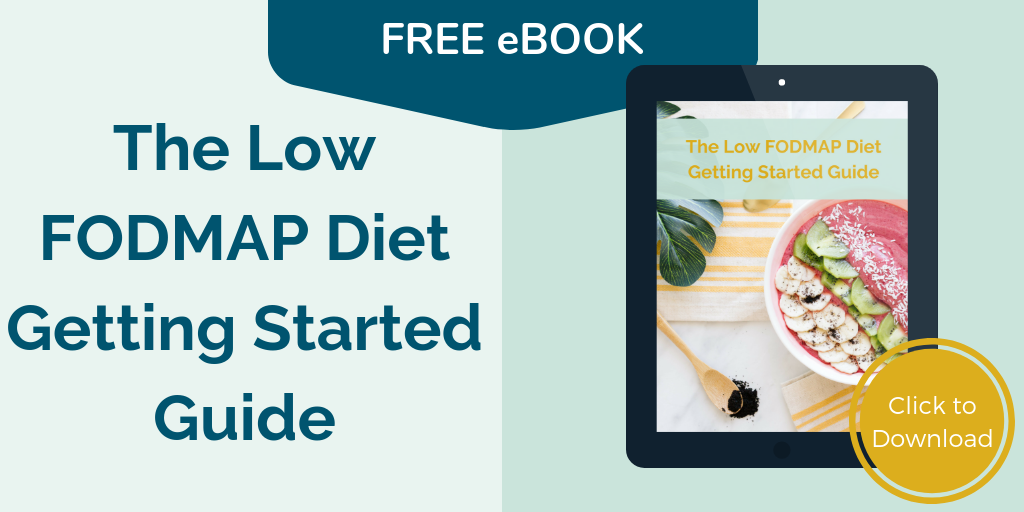Welcome to the second week of 2015! As many of you are trying to decide on a new goal to accomplish for this year, also known as a New Year’s Resolution, our team wanted to help you out with one of the most common resolutions set – saving money! This week’s post is all about tips and tricks to save you money when shopping with a food allergy or intolerance, and of course, when following the low FODMAP diet. When excluding foods from your diet and choosing alternatives, many of the alternatives may seem more expensive. Not to worry, the team and I have come up with 10 great strategies to help you not break the bank this year when feeding yourself and your family.
The first step if you’re looking to improve irritable bowel syndrome (IBS) or another digestive disorder or disease, is to understand more about the Low FODMAP diet and if it can help. Download my free eBook to help you better understand this diet and get started implementing simple steps to get rid of symptoms like gas, bloating, pain, diarrhea or constipation related to IBS. Click here to get a copy emailed to you right away.
How to Eat Low FODMAP on a Budget
1. Use Real Garlic
Garlic is high in FODMAPs, sugars that are poorly digested, so it can be really irritating for those who have digestive distress and something that needs to be avoided. To get garlic flavour in your dishes, you can use garlic infused olive oil, however specialty oils tend to be pretty pricey.
Save Money Strategy: Add a 2 to 3 whole cloves of garlic to a bottle of olive oil to make your own infused oil OR to the olive oil in your pan/pot at the beginning of cooking. Be sure to take the garlic out after cooked in the oil for 2-3 minutes.
2. Use a Whole Lot Less Fennel
Onion is an aromatic vegetable that adds loads of flavour to dishes, but is high in FODMAPs so should be avoided for those with digestive distress. A whole bag of onions is only a couple of dollars while a fennel bulb, which is a great substitute for onion in recipes, can be almost the same price!
Save Money Strategy: Stretch that fennel bulb. Replace ½ to 1 whole onion in a recipe with just 2 to 4 tablespoons of diced fennel bulb. This is perfect for soups, stews, sauces and all your recipes that require onion.
3. Shop the Sales
Every week grocery stores have sales on various food products to get you into their store. Lactose is one high FODMAP ingredient, so choosing alternatives to cow’s milk like lactose-free cow’s milk, almond milk or soy milk (good for lactose-free diet but now low FODMAP diet) can usually be found on sale each week at many of the major grocery store.
Save Money Strategy: Use flyers to scout out sales and coupons at the checkout as great ways to save money while buying the foods you love. Stock up on items that can be stored like tetra almond milk, canned or dried lentils and chickpeas, broth, canned tomatoes, olive oil, frozen gluten-free bread, etc.
4. Choose Naturally “Free” Foods
It may seem that many foods contain gluten, lactose, nuts, and other common allergies and intolerances. When making a “swap” of gluten-free or lactose-free foods for regular foods, the price is often higher and can rack up your bill. However, there are a lot of foods that are naturally gluten and lactose-free and can help you save money while being healthy.
Save Money Strategy: Choose naturally free starches to replace wheat like potatoes, sweet potatoes, squash, rice, rice noodles, polenta and quinoa. These starches won’t cause any digestive distress and they cost less than a processed gluten-free grain products. Some cheeses are naturally lactose-free so they’ll be safe for your gut as well. For more about lactose-free cheese, read this article.
5. Shop at Wholesale Stores
Wholesale stores like Costco and Sam’s Club have been expanding their assortment of gluten-free and other allergen-free foods. Because you are buying in a larger quantity, there are great savings to be had!
Save Money Strategy: Although there is a yearly membership fee for these stores, if you’re shopping for a family and will be going regularly, it’s worth the fee. Not only will you save money by stocking up… but also with less trips to the store in the long run.

6. Bake Your Own Snacks
Gluten-free and other allergen-free baked goods are readily available at most grocery store. Purchasing these items can be great when you’re in a time crunch, but can really increase your grocery bill.
Save Money Strategy: You can simply turn your favourite recipe into a digestive friendly one with a few swaps. Just swap out regular flour for a gluten-free flour blend like Namaste or Bob’s Red Mill Brand and you’re on your way to a baked good that won’t cause any digestive distress. Get more tips for gluten-free baking here.
7. Pack a Lunch
I love stopping at a restaurant or café for a quick bite to eat, which often happens when I’m travelling. Often restaurants charge several dollars extra for things like gluten-free bread, pizza crust and dairy-free milk alternatives.
Save Money Strategy: Make your own lunch at home as often as possible. Preparing food ahead of time and bringing it with you allows you to have the food you love, without the extra costs. For more tips on packing healthy lunches, check out our blog post Love Your Lunch: Tips for Creating Healthy and Delicious Lunches.
8. Have Packaged Food Just Once a Day
It’s much easier to swap out your crackers, cookies, muffins, cereal, bread and other favourites for a gluten-free alternative these days. Although this can save time and is a real treat, these foods will rack up your grocery spending needlessly. When trying to eat well for energy and overall health, packaged food should not be consumed 3, 4 or 5 times per day!
Save Money Strategy: Consume packaged food once a day – that means either cereal or toast in the morning OR crackers or cookies during the day. This can be challenging at first, but do your best to wean yourself off these processed foods. You should aim for a maximum of two servings per day with a long-term goal of just once. For the rest of your meals and snacks use naturally free starchy foods like rice, potato, or fruit, or make your own baked goods.

9. Choose Noodle Alternatives
Pasta and most noodles contains wheat and gluten, which we know can be tough to digest when you suffer from IBS and should be avoided for Celiac disease and other digestive issues. There are many gluten-free pasta options available, but they can be pricey. If you can’t grab them on sale, there are alternatives that will save you money.
Save Money Strategy: Instead of gluten-free pasta, try low FODMAP vegetable noodles like zucchini noodles or spaghetti squash. They’re inexpensive and are a delicious base for a pasta dish. Use rice noodles instead of soba or other expensive Asian noodles.
10. Tax Deduction
As discussed today, buying gluten-free products as alternatives to your usual foods made with wheat can increase your grocery bill. In addition to all the strategies shared in this article, there is one more way to save money.
Save Money Strategy: The Canadian government has created a tax deduction on gluten-free products for those diagnosed with Celiac Disease. If you have been diagnosed, take advantage of this – go to the Canada Revenue Agency website to find out more information (scroll down to item 1.136).
What are your tips to save money when avoiding gluten, lactose, or other foods? As always, we would love to hear from you! Please share in the comment section below.
Much love & good eating,
Stephanie & the Team


